Earl Burns Miller Japanese Garden

|
||
| Licensing | ||
Dedicated in April 1981, the Earl Burns Miller Japanese Garden is 1.5-acre garden situated on the campus of California State University of Long Beach. The construction of the garden was made possible through the generosity of Loraine Miller Collins, and was named in honor of her late husband. Collins envisioned the garden as a haven of peace, tranquility, and beauty. Though the garden embodies such an atmosphere, it also goes beyond to serve as an educational and cultural resource for both the campus and community.
The garden is collection of various types of Japanese gardens, capturing the overall essence of Japan. The garden was designed by the master landscape architect for CSULB, Edward Lovell, who, in preparation for the project, visited Japanese gardens both in Japan and the United States. In attempting to understand the significance of the Japanese garden and to successfully translate the experience in a new setting, Lovell created a cohesive garden that acts as a survey of Japanese culture. Thus, the garden is a combination of stroll, tea, and rock gardens. The path of the garden wraps around the koi-filled lake, crossing two bridges, two waterfalls, and various flora characteristic of Japanese gardens. Aside from the flora, there are a number of stone lanterns and pagodas, many of which were imported from Japan.
Despite its apparent mélange of gardens, there is an effort to keep the three types seamlessly separate from each other. The small teahouse is hidden behind a screen of plants and trees and may be reached by going up the inclined path that deviates from the main path. Moreover, the Zen rock garden (or karesansui), which lies adjacent to the teahouse, is isolated from the main path by a “living screen” made of bamboo, allowing visitors to experience the tranquility of the Zen garden without the distraction of people walking by. However, for the very reason of its carefully organized collection of gardens, structures, and flora, the Earl Burns Miller Japanese Garden may only be seen as a translation of the “authentic” Japanese garden.
The Earl Burns Miller Japanese Garden functions in numerous ways beyond its most basic role of a place of beauty and serenity. First, the garden itself becomes a center for cultural exchange. The garden hosts a range of events throughout the year, from tea ceremonies to origami festivals to its annual Japanese Garden Horticulture Symposium. More interestingly, though, is the way that different cultural groups are able to make use of the garden for their own purposes. For example, the National Council of La Raza hosted an event at the garden, and a small Christian ministry school held its graduation there as well.
Similar to its cultural edification, the garden is a vital educational source for the community. Its unique location on a university campus and its proximity to at least eight elementary, middle, and high schools makes the garden a popular site for field trips and classroom activities. On any day, a group of students may be seen painting or sketching, or learning about Japanese culture and the flora of the garden. Also, in 2000, the Educational Outreach Committee was formed, which, according to the garden’s website, is dedicated “to support the educational experience at the Japanese Garden and the utilization of the garden’s aesthetic and cultural resources.”
Lastly, the garden becomes a kind of commodity, in that it may be rented out for personal occasions, thereby rendering a personalized Japanese garden experience. The garden may be rented for weddings, memorial services, luncheons, Japanese tea tasting and tour, and other social events. The garden also offers a “Dinner for two” package that includes the meal, music, beautiful lighting, and other amenities to create the “perfect” atmosphere for romantic dates and proposals. Here, the meaning of the garden as a beautiful, relaxing atmosphere is extended to easily attainable romance and splendor in the perfecting of the most memorable occasions. Though its commodification is a convenient way to fund the maintenance of the garden, the original intention of Japanese gardens is translated and stretched into an economic venture.
Yet this is why Japanese-style gardens are significant, for it tells more about the culture that re-created than the culture that is being created. The “disjuncture between the form, rhetoric, and actual function” (Brown 9) of Japanese-style gardens hints at the intricate process of designing such gardens, the diversity of all the people involved in the project from its beginning until now, and the fluidity of meaning and function across time. The Earl Burns Miller Japanese Garden makes no boisterous claim to being authentically Japanese. Rather, the traditional meaning of the garden in Japanese culture is intermixed with its present goals of cultural exchange and education. Loraine Miller Collins and Edward Lovell originally envisioned the garden to be a place of beauty. But now, the garden has become an indispensable aesthetic, cultural, and educational source for the entire community.
Sources
Additional information may be viewed on the website:
Earl Burns Miller Japanese Garden
Slides in this album |
|
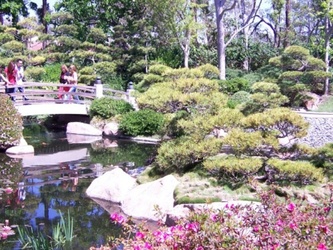
|
Garden ViewThe small, inaccessible island lies in the middle of the pond. The moon bridge and black pebble beach can be seen just beyond the island. |
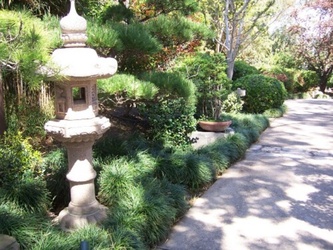
|
Entrance PathJust outside the entry gate to the Earl Burns Miller Japanese Garden stands a Kasuga stone lantern, along with Japanese black pines.
Entrance Path |

|
BonsaiA relatively inconspicuous marker for the bonsai collection. |

|
BonsaiLined up outside of the entry gate to the Earl Burns Miller Garden are a variety of bonsai. |
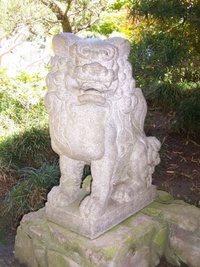
|
Koma-InuOne of the two koma-inu (lion dog) that guards the gate to the Earl Burns Miller Japanese Garden. |

|
Black-Stemmed BambooUpon entering the Earl Burns Miller Japanese Garden, the first thing that can be seen is the small black stemmed bamboo grove, partially shielding the entire view of the garden.
Black Stemmed Bamboo |

|
Black Pebble BeachThe black stones spread out across the edge of the lake are intended to represent water. The Yukimi-doro lantern can also be seen.
Black Pebble Beach |
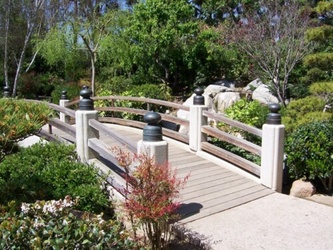
|
The Moon BridgeThe arched bridge crosses the waterfall and stream.
Moon Bridge |
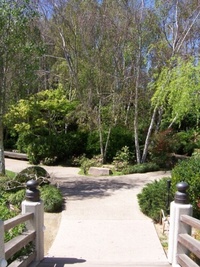
|
PathThe diverging pathway from the moon bridge, with the left path leading around the lake towards the rock garden and the right path leading up to the teahouse. |
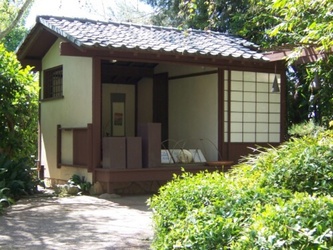
|
TeahouseThe small teahouse is isolated from the rest of the garden. Tea ceremonies are often held here as both public and private events. |
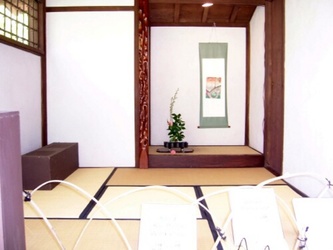
|
Teahouse - InteriorThe interior of the teahouse.
Teahouse - Interior |

|
TsukubaiThe tsukubai, or stone wash basin, is located opposite the teahouse. |

|
Nure-Sage LanternThe nure-sage lantern stands just behind the tsukubai near the teahouse.
Nure-Sage Lantern |
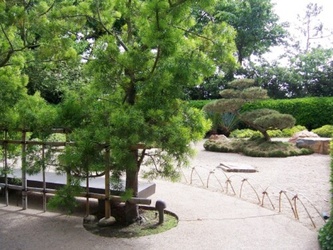
|
KaresansuiThe Japanese rock garden (karesansui) is located directly next to the teahouse. The bamboo fence is set up as an attempt to isolate the rock garden and its viewers from the other visitors walking by.
Rock Garden |

|
Koi FishThe Koi fish are an instant favorite with visitors of the Earl Burns Miller Japanese Garden. Visitors are also able to feed the fish. |
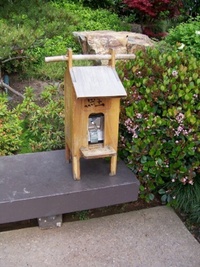
|
Koi Fish Food DispenserThe Koi food dispenser situated on a bench.
Koi Food Dispenser |

|
Koi Fish FeedingPeople clustering to observe and feed the koi fish.
Koi Fish Feeding |
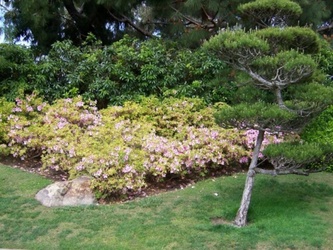
|
Tree & PlantsA glimpse of the many trees, plants, and flowers at the garden.
Tree & Flowers |
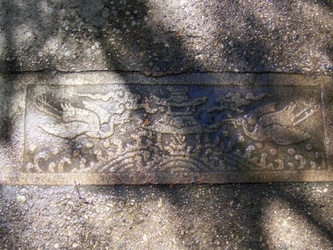
|
Step Stone - PhoenixThe second step-stone, depicting a phoenix, is embedded in the pathway leading to the teahouse.
Step Stone - Phoenix |
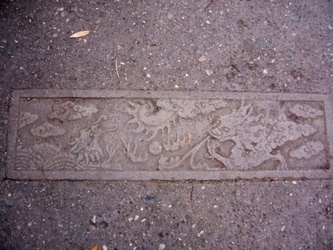
|
Step Stone - DragonThe step-stone depicting a dragon is embedded in the pathway at the entry gate.
Step Stone - Dragon |

|
Zig-Zag BridgeThe zig zag bridge crosses the other waterfall in the garden.
Zig Zag Bridge |
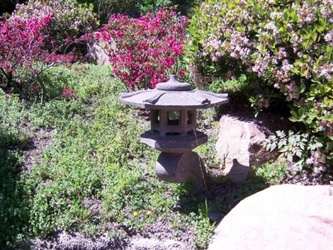
|
Stone LanternAnother stone lantern in the Earl Burns Miller Japanese Garden, located next to the waterfall and zig zag bridge.
Stone Lantern |
Part of these albums

|
Landscaping America: Occidental College Student Research mpitelka
mpitelka
|

|
 dotdotdot
dotdotdot
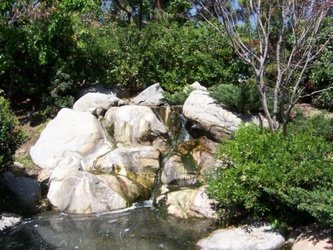


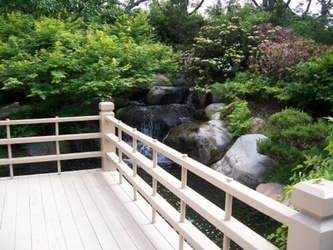
 Earl Burns Miller Japanese Garden
Earl Burns Miller Japanese Garden
 Journal feed
Journal feed
